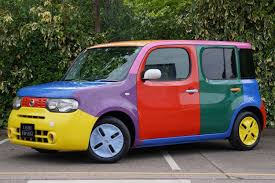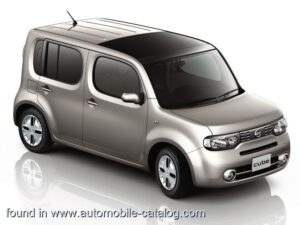First Impressions: Not Just Another Car
At first glance, the Nissan Cube looks like it doesn’t belong on the road. Its bold, boxy shape is nothing like the sleek curves and smooth lines of most modern cars. But that’s exactly what made the Cube so special. It didn’t try to fit in—it wanted to stand out. And for a certain kind of driver, it did more than that. It made them feel seen.
In a world of predictable cars, the Cube offered something different: a sense of fun, function, and flair. Behind its strange shape was a smart design meant for everyday life, especially in cities. And beneath its quirky charm was a message—being different isn’t just okay, it’s a good thing.
Heading: The Nissan Cube: More Than Just a Shape
Launched in 1998 in Japan, the Nissan Cube was never intended to look like a typical car. Its designers imagined a vehicle that felt like a comfortable room on wheels—a mobile space where you could relax, think, and even enjoy your daily commute.
By the time it reached North America in 2009, the Cube had evolved into a truly unique car. With its wide windows, upright windshield, and asymmetrical rear window that curved only on one side, the Cube was immediately recognizable. Some people laughed. Others fell in love.
But this wasn’t just a case of “weird for weird’s sake.” The design served a purpose. The boxy frame gave the Cube a spacious interior. The high roof made it feel open and airy. The flat sides made parking easier. It was a perfect mix of practicality and personality.
Inside, things were just as bold. The dashboard had wave-inspired curves. The seats were comfortable and supportive. Some trims even had details like circular ripple patterns in the ceiling, designed to create a calming atmosphere. The Cube felt more like a lounge than a car—and that was the point.
Built for Urban Living
The Nissan Cube wasn’t built to race down highways or go off-roading. It was made for cities—for weaving through traffic, fitting into small parking spaces, and making every errand a little more enjoyable.
It came with a 1.8-liter four-cylinder engine, which gave enough power for city driving while staying fuel-efficient. The CVT (Continuously Variable Transmission) offered smooth acceleration and better gas mileage. The Cube was quiet, easy to drive, and surprisingly roomy for its small footprint.
Its rear door opened like a refrigerator—swinging to the side instead of lifting upward—which made it easier to load groceries or gear in tight spaces. The rear seats could fold down or slide to offer more room for cargo. Everything about the Cube was made to be useful.
The Crowd It Attracted
You might not think a car’s shape could say something about you—but the Nissan Cube did exactly that. It became a symbol of creativity and individuality.
Artists, students, and people who wanted something “not boring” were drawn to it. The Cube wasn’t loud or flashy, but it had charm. It was different without trying too hard. It was soft around the edges, both literally and emotionally.
Owners often decorated their Cubes with fun seat covers, dashboard toys, or colorful decals. It wasn’t just transportation—it was an extension of their personality. In a sea of grey sedans, the Cube was like a little moving art piece.
A Short Life, A Lasting Memory
Unfortunately, not everyone appreciated the Cube’s uniqueness. After just a few years in markets outside Japan, including the U.S. and Canada, sales slowed. Some drivers found the design too strange. Others preferred more traditional options. In 2014, Nissan discontinued the Cube in North America.
But the story doesn’t end there.
Though no longer in production, the Cube has lived on in memory—and on the road. It’s become something of a cult favorite among car lovers who admire its daring style. Used Nissan Cubes still sell today, and many owners continue to drive them proudly.
In a world where so many cars look alike, the Cube is still instantly recognizable.
What We Can Learn from the Cube
The Nissan Cube teaches us a few things, not just about cars, but about design and daring.
It reminds us that function and fun can go hand-in-hand. That comfort doesn’t have to be boring. That standing out isn’t something to fear—it can be something to celebrate.
The Cube showed that cars don’t have to be aggressive or flashy to be cool. They can be gentle, soft-spoken, and still have a big impact. It was a car that invited smiles, not stares. It made people feel like driving could be joyful again.
In many ways, the Cube was ahead of its time. As cities grow and people look for smarter, more personal cars, the Cube’s blend of practicality and personality makes even more sense now than it did a decade ago.
The Future of Quirky Cars
Today, many automakers are experimenting with bolder, more playful designs—especially in the world of electric cars. From compact EVs to futuristic ride-sharing vehicles, the Cube’s influence can still be seen.
Cars like the Kia Soul and Honda e echo some of the same themes: small footprint, spacious interior, and a design that isn’t afraid to be different. And while there’s still nothing exactly like the Cube on the market, the world seems more ready for cars with a little character.
Maybe someday, Nissan will bring it back—or introduce something even more daring.
Final Thoughts
The Nissan Cube was never meant to be just another car. It was a quiet rebellion against boring design. It offered a new way to think about driving—less about performance, and more about experience. Comfort. Joy. Style.
Even though it didn’t last long on showroom floors, it left behind a lasting impression. For those who owned one, or even just admired one from the sidewalk, the Cube proved that sometimes, the square peg doesn’t need to fit into the round hole—it can just roll on, happily, as itself.








ungxz7
THANXS